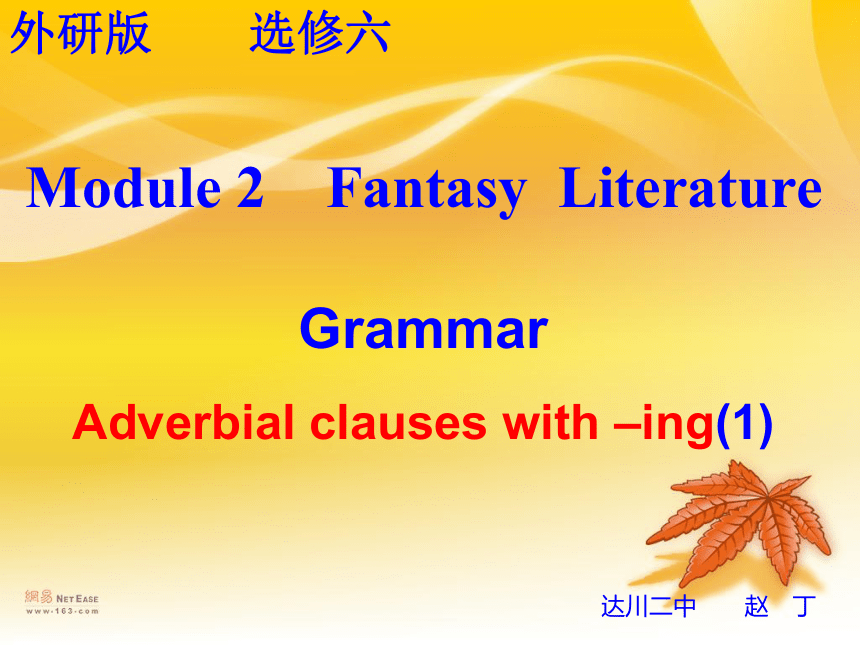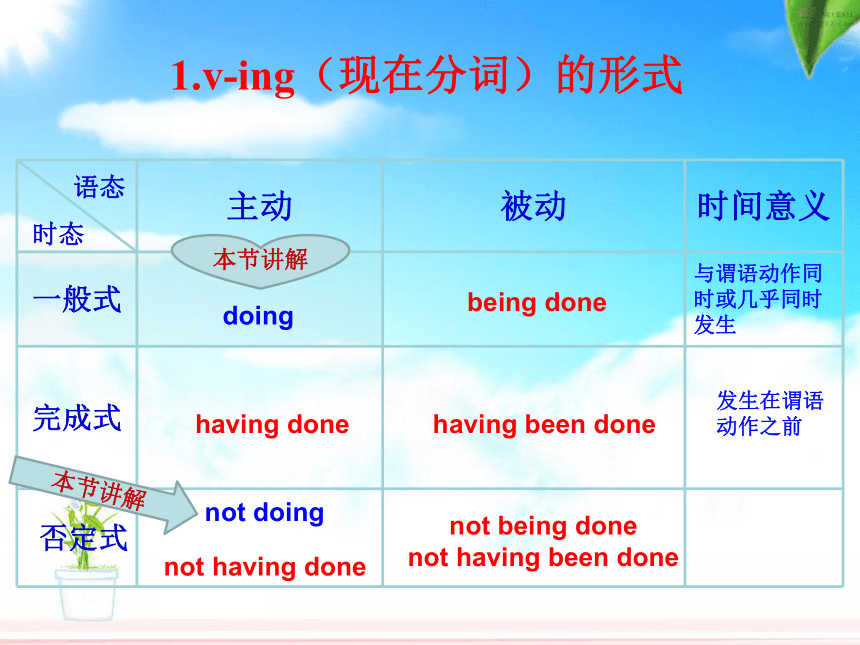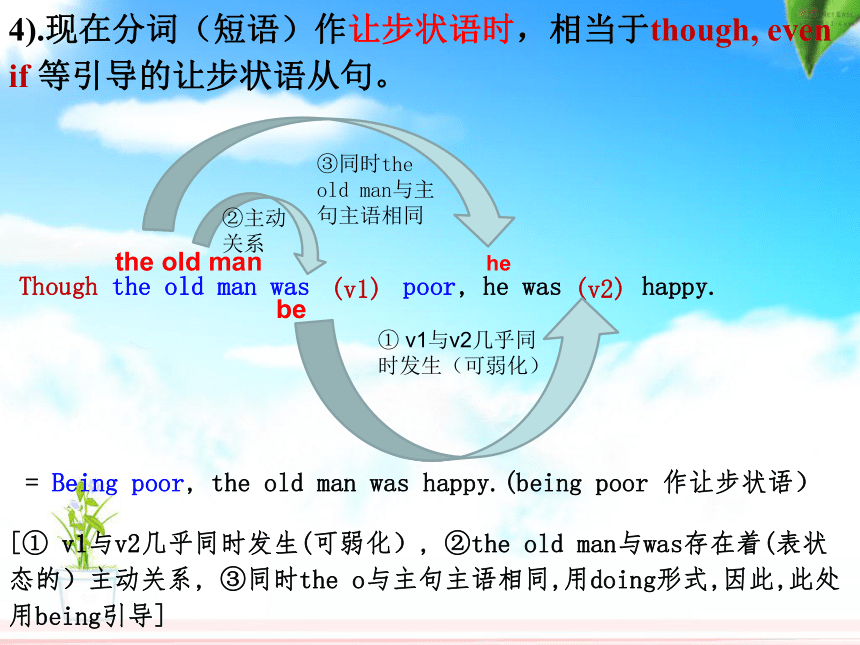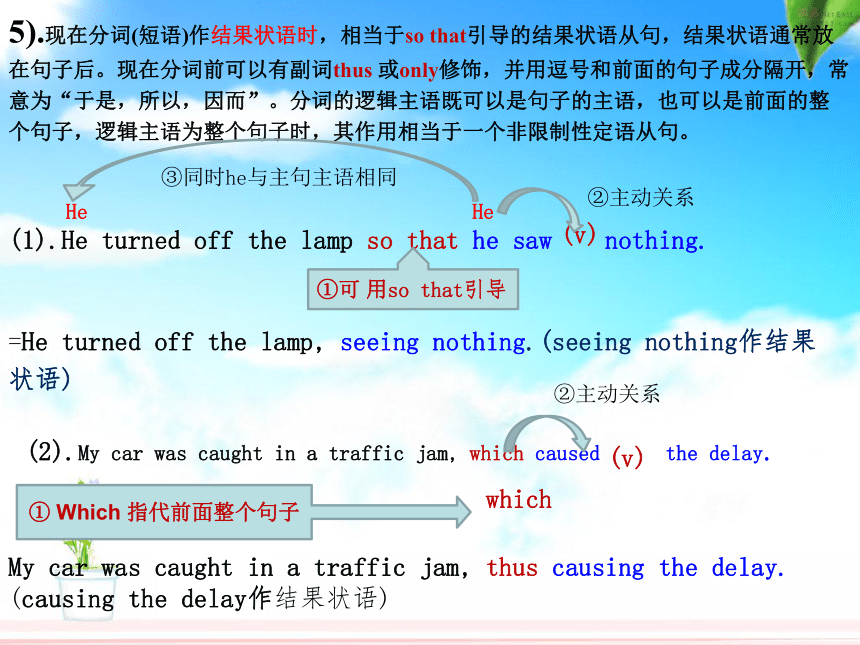外研版选修6 Module 2 Fantasy Literature – Philip Pullman Grammar 课件(22张PPT)
文档属性
| 名称 | 外研版选修6 Module 2 Fantasy Literature – Philip Pullman Grammar 课件(22张PPT) |  | |
| 格式 | zip | ||
| 文件大小 | 1012.0KB | ||
| 资源类型 | 教案 | ||
| 版本资源 | 外研版 | ||
| 科目 | 英语 | ||
| 更新时间 | 2020-05-17 08:27:09 | ||
图片预览









文档简介
(共22张PPT)
外研版 选修六
Grammar
Adverbial clauses with –ing(1)
Module 2 Fantasy Literature
达川二中 赵 丁
语态
时态
1.v-ing(现在分词)的形式
本节讲解
本节讲解
being done
having been done
not being done
not having been done
not doing
not having done
having done
doing
发生在谓语动作之前
主动 被动 时间意义
一般式 与谓语动作同时或几乎同时发生
完成式
否定式
2. v-ing(现在分词)的含义:
v-ing(现在分词),在句中作状语,通常表示主语正在进行的另一动作,用来对句子谓语动词起修饰和陪衬的作用。
1). 时间
2). 条件
3). 原因
4). 让步
5). 结果
6). 方式或伴随状语情况等
现在分词在句中作状语可以表示
相当于对应的状语从句
When she came into the room,?she saw everybody already at their work.
she
she
1).现在分词(短语)作时间状语时,相当于when引导的时间状语从句,状语常放在句子的前半部分。
(v1)
(v2)
Coming
① v1与v2几乎同时发生
②主动关系
③同时she与主句主语相同
=Coming into the room, she saw everybody already at their work.(coming into the room作时间状语)
[① v1与v2同时发生, ②she与came存在着主动关系, ③同时she与主句主语相同,用doing形式,因此,此处用coming引导]
2).现在分词(短语)作条件状语时,相当于if, unless等引导的条件状语从句。
If you look out of the window, you can have a full
view of the beach. ?
=Looking out of the window, you can have a full view of the beach.
(Looking out of the window作条件状语)
?
(v1)
(v2)
① v1与v2几乎同时发生(可弱化)
you
you
②主动关系
③同时you与主句主语相同
Looking
[① v1与v2几乎同时发生(可弱化), ②you与look存在着主动关系, ③同时you与主句主语相同,用doing形式,因此,此处用looking引导]
[① v1与v2几乎同时发生(可弱化), ②I与knowing存在着主动关系, ③同时I与主句主语相同,用doing形式,因此,此处用knowing引导]
3).现在分词(短语)作原因状语时,相当于as, since, because引导的原因状语从句,状语多放在句子的前半部分。
As I don’t know his address, I can’t send this book to him.
(v1)
(v2)
① v1与v2几乎同时发生(可弱化)
I
②主动关系
I
③同时I与主句主语相同
Not knowing his address, I can’t send this book to him.
(not knowing his address作原因状语)
Not knowing
4).现在分词(短语)作让步状语时,相当于though, even if 等引导的让步状语从句。
= Being poor, the old man was happy.(being poor 作让步状语)
Though the old man was poor, he was happy.
(v1)
(v2)
① v1与v2几乎同时发生(可弱化)
the old man
be
he
②主动关系
③同时the old man与主句主语相同
[① v1与v2几乎同时发生(可弱化), ②the old man与was存在着(表状态的)主动关系, ③同时the o与主句主语相同,用doing形式,因此,此处用being引导]
5).现在分词(短语)作结果状语时,相当于so that引导的结果状语从句,结果状语通常放在句子后。现在分词前可以有副词thus 或only修饰,并用逗号和前面的句子成分隔开,常意为“于是,所以,因而”。分词的逻辑主语既可以是句子的主语,也可以是前面的整个句子,逻辑主语为整个句子时,其作用相当于一个非限制性定语从句。
=He turned off the lamp, seeing nothing.(seeing nothing作结果状语)
My car was caught in a traffic jam, thus causing the delay. (causing the delay作结果状语)
(1).He turned off the lamp so that he saw nothing.
(2).My car was caught in a traffic jam, which caused the delay.
①可 用so that引导
He
He
③同时he与主句主语相同
(v)
②主动关系
① Which 指代前面整个句子
which
(v)
②主动关系
=Traveling by train, we visited a number of cities. (traveling by train作方式状语)
6).作方式或伴随状语时,不能用状语从句替换,但可以改成并列句。
(1-1).He was talking all the while as if he were talking to himself.
=He was talking all the while as if talking to himself.(as if talking to himself.作方式状语)
(1-2).We traveled by train and visited a number of cities.
we
(v2)
and
①可保留as if 参照
he
(v)
④ be 动词去掉
②主动关系
(v)
(v1)
he
③主语相同
②主动关系
①v1 and v2是并列关系,同一主语
③可通过by参照
=They stood there, watching the stars in the sky.
(watching the stars in the sky作伴随状语)
(2).They stood there and watched the stars in the sky.
(v2)
(v1)
and
①v1 and v2是并列(伴随)关系,同一主语
(v)
they
②主动关系
1).为强调与谓语动词的动作同时发生,在-ing形式短语前可用连词when, while等;为强调在谓语动词的动作之前或之后发生,在-ing形式短语前可用连词before或after
e.g. (1) Be careful when crossing the road.
(2) Don’t laugh while eating.
(3) Before going abroad, he lived here.
(4) After watching TV, he went to bed.
when crossing
while eating
Before going
After watching
2).在现在分词-ing形式短语前可though/although表示让步
Though he worked very hard, he couldn’t make enough money to pay off his debt.
= Though working very hard, he couldn’t make enough money to pay off his debt.
Though working
3).介词in, on + v-ing也是常见的时间表示法。
on+现在分词相当于as soon as,强调瞬间的动作;
in+现在分词相当于when, while,强调的是连续缓慢的动作。
(1).On hearing the town, he went direct to the hotel.
= As soon as he heard the town, he went direct to the hotel.
(2).In doing the work, he met a lot of difficulties.
= While he was doing the work, he met a lot of difficulties.
4).固定结构:
Judging from his appearance, he must be very rich.
Generally speaking, his answer is right.
Considering everything, they did a good job.
根据…判断,由…推测
一般而言,总体上讲
考虑一切,考虑到各种情况
1).Complete the sentences with the correct form of the verbs below and rewrite them.
(1). On______ her, the king immediately falls in love with her.
(2). He marries her, not _______ who she really is.
think know sit see leave
He marries her, but he doesn’t know who she really is.
As soon as the king sees her, he immediately falls in love with her.
seeing
knowing
(3). Before _______ his kingdom, the king calls his son to him.
(4). After________ about the situation, he decides to kill the witch himself.
(5). While _______ by a pool, Ferdinand sees a frog.
Before the king leaves, he calls his son to him.
After he thinks about the situation, he decides to kill the witch himself.
While he is sitting by a pool, Ferdinand sees a frog.
leaving
thinking
sitting
(1). The secretary worked late into the night, ____ a long speech for the president.
A. to prepare B. preparing
C. prepared D. was preparing
(2). _____ your homework, you mustn’t listen to music.
A. When do B. When to do
C. When doing D. When you doing
2).Choose the best answer.
(3). “Can’t you read?” she said angrily, _____ to the notice.
A. pointed B. and pointing
C. pointing D. to point
(4). It rained heavily, ______ severe flooding in the country.
A. causing B. to cause
C. caused D. having caused
Ex.3 and Ex.4 on Page 21
外研版 选修六
Grammar
Adverbial clauses with –ing(1)
Module 2 Fantasy Literature
达川二中 赵 丁
语态
时态
1.v-ing(现在分词)的形式
本节讲解
本节讲解
being done
having been done
not being done
not having been done
not doing
not having done
having done
doing
发生在谓语动作之前
主动 被动 时间意义
一般式 与谓语动作同时或几乎同时发生
完成式
否定式
2. v-ing(现在分词)的含义:
v-ing(现在分词),在句中作状语,通常表示主语正在进行的另一动作,用来对句子谓语动词起修饰和陪衬的作用。
1). 时间
2). 条件
3). 原因
4). 让步
5). 结果
6). 方式或伴随状语情况等
现在分词在句中作状语可以表示
相当于对应的状语从句
When she came into the room,?she saw everybody already at their work.
she
she
1).现在分词(短语)作时间状语时,相当于when引导的时间状语从句,状语常放在句子的前半部分。
(v1)
(v2)
Coming
① v1与v2几乎同时发生
②主动关系
③同时she与主句主语相同
=Coming into the room, she saw everybody already at their work.(coming into the room作时间状语)
[① v1与v2同时发生, ②she与came存在着主动关系, ③同时she与主句主语相同,用doing形式,因此,此处用coming引导]
2).现在分词(短语)作条件状语时,相当于if, unless等引导的条件状语从句。
If you look out of the window, you can have a full
view of the beach. ?
=Looking out of the window, you can have a full view of the beach.
(Looking out of the window作条件状语)
?
(v1)
(v2)
① v1与v2几乎同时发生(可弱化)
you
you
②主动关系
③同时you与主句主语相同
Looking
[① v1与v2几乎同时发生(可弱化), ②you与look存在着主动关系, ③同时you与主句主语相同,用doing形式,因此,此处用looking引导]
[① v1与v2几乎同时发生(可弱化), ②I与knowing存在着主动关系, ③同时I与主句主语相同,用doing形式,因此,此处用knowing引导]
3).现在分词(短语)作原因状语时,相当于as, since, because引导的原因状语从句,状语多放在句子的前半部分。
As I don’t know his address, I can’t send this book to him.
(v1)
(v2)
① v1与v2几乎同时发生(可弱化)
I
②主动关系
I
③同时I与主句主语相同
Not knowing his address, I can’t send this book to him.
(not knowing his address作原因状语)
Not knowing
4).现在分词(短语)作让步状语时,相当于though, even if 等引导的让步状语从句。
= Being poor, the old man was happy.(being poor 作让步状语)
Though the old man was poor, he was happy.
(v1)
(v2)
① v1与v2几乎同时发生(可弱化)
the old man
be
he
②主动关系
③同时the old man与主句主语相同
[① v1与v2几乎同时发生(可弱化), ②the old man与was存在着(表状态的)主动关系, ③同时the o与主句主语相同,用doing形式,因此,此处用being引导]
5).现在分词(短语)作结果状语时,相当于so that引导的结果状语从句,结果状语通常放在句子后。现在分词前可以有副词thus 或only修饰,并用逗号和前面的句子成分隔开,常意为“于是,所以,因而”。分词的逻辑主语既可以是句子的主语,也可以是前面的整个句子,逻辑主语为整个句子时,其作用相当于一个非限制性定语从句。
=He turned off the lamp, seeing nothing.(seeing nothing作结果状语)
My car was caught in a traffic jam, thus causing the delay. (causing the delay作结果状语)
(1).He turned off the lamp so that he saw nothing.
(2).My car was caught in a traffic jam, which caused the delay.
①可 用so that引导
He
He
③同时he与主句主语相同
(v)
②主动关系
① Which 指代前面整个句子
which
(v)
②主动关系
=Traveling by train, we visited a number of cities. (traveling by train作方式状语)
6).作方式或伴随状语时,不能用状语从句替换,但可以改成并列句。
(1-1).He was talking all the while as if he were talking to himself.
=He was talking all the while as if talking to himself.(as if talking to himself.作方式状语)
(1-2).We traveled by train and visited a number of cities.
we
(v2)
and
①可保留as if 参照
he
(v)
④ be 动词去掉
②主动关系
(v)
(v1)
he
③主语相同
②主动关系
①v1 and v2是并列关系,同一主语
③可通过by参照
=They stood there, watching the stars in the sky.
(watching the stars in the sky作伴随状语)
(2).They stood there and watched the stars in the sky.
(v2)
(v1)
and
①v1 and v2是并列(伴随)关系,同一主语
(v)
they
②主动关系
1).为强调与谓语动词的动作同时发生,在-ing形式短语前可用连词when, while等;为强调在谓语动词的动作之前或之后发生,在-ing形式短语前可用连词before或after
e.g. (1) Be careful when crossing the road.
(2) Don’t laugh while eating.
(3) Before going abroad, he lived here.
(4) After watching TV, he went to bed.
when crossing
while eating
Before going
After watching
2).在现在分词-ing形式短语前可though/although表示让步
Though he worked very hard, he couldn’t make enough money to pay off his debt.
= Though working very hard, he couldn’t make enough money to pay off his debt.
Though working
3).介词in, on + v-ing也是常见的时间表示法。
on+现在分词相当于as soon as,强调瞬间的动作;
in+现在分词相当于when, while,强调的是连续缓慢的动作。
(1).On hearing the town, he went direct to the hotel.
= As soon as he heard the town, he went direct to the hotel.
(2).In doing the work, he met a lot of difficulties.
= While he was doing the work, he met a lot of difficulties.
4).固定结构:
Judging from his appearance, he must be very rich.
Generally speaking, his answer is right.
Considering everything, they did a good job.
根据…判断,由…推测
一般而言,总体上讲
考虑一切,考虑到各种情况
1).Complete the sentences with the correct form of the verbs below and rewrite them.
(1). On______ her, the king immediately falls in love with her.
(2). He marries her, not _______ who she really is.
think know sit see leave
He marries her, but he doesn’t know who she really is.
As soon as the king sees her, he immediately falls in love with her.
seeing
knowing
(3). Before _______ his kingdom, the king calls his son to him.
(4). After________ about the situation, he decides to kill the witch himself.
(5). While _______ by a pool, Ferdinand sees a frog.
Before the king leaves, he calls his son to him.
After he thinks about the situation, he decides to kill the witch himself.
While he is sitting by a pool, Ferdinand sees a frog.
leaving
thinking
sitting
(1). The secretary worked late into the night, ____ a long speech for the president.
A. to prepare B. preparing
C. prepared D. was preparing
(2). _____ your homework, you mustn’t listen to music.
A. When do B. When to do
C. When doing D. When you doing
2).Choose the best answer.
(3). “Can’t you read?” she said angrily, _____ to the notice.
A. pointed B. and pointing
C. pointing D. to point
(4). It rained heavily, ______ severe flooding in the country.
A. causing B. to cause
C. caused D. having caused
Ex.3 and Ex.4 on Page 21
